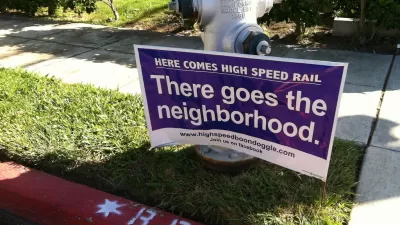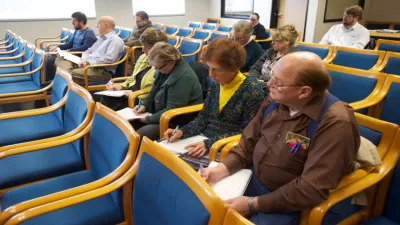"To get beyond NIMBYism, we first must understand it," writes Richard Florida.

Richard Florida shares insights into a recent white paper published in December 2016 by Paavo Monkkonen, which "sheds interesting new light on the connection between NIMBYism and housing affordability. It takes a deep dive into, on the one hand, neighborhood opposition and land use restrictions, as well as housing supply and housing costs in Los Angeles, San Francisco, and California’s other expensive housing markets."
According to Florida, Monkkonen identifies in the white paper "four different strains of NIMBYism and their underlying motivations." That taxonomy of opposition, with more detail in the article responds to the following concerns: 1) traffic and parking, 2) strains on services, environmental preservation, and 4) neighborhood character.
Monkkonen also posits four strategies for surmounting the obstructionist effects of NIMBYs: 1) better use of existing housing policies, 2) inclusive planning, 3) better data, information, and nonpartisan analysis, and 4) and a shift in land use power to the regional level.
Not mentioned in Florida's analysis of the white paper (but another motivating factor for NIMBYism that often goes unrecognized) are communitarian interests (as opposed to self-interest, i.e., concern about property values), as described in a blog post by Prof. Lisa Schweitzer last year.
FULL STORY: Anatomy of a NIMBY

Planetizen Federal Action Tracker
A weekly monitor of how Trump’s orders and actions are impacting planners and planning in America.

San Francisco's School District Spent $105M To Build Affordable Housing for Teachers — And That's Just the Beginning
SFUSD joins a growing list of school districts using their land holdings to address housing affordability challenges faced by their own employees.

The Tiny, Adorable $7,000 Car Turning Japan Onto EVs
The single seat Mibot charges from a regular plug as quickly as an iPad, and is about half the price of an average EV.

With Protected Lanes, 460% More People Commute by Bike
For those needing more ammo, more data proving what we already knew is here.

In More Metros Than You’d Think, Suburbs are Now More Expensive Than the City
If you're moving to the burbs to save on square footage, data shows you should think again.

The States Losing Rural Delivery Rooms at an Alarming Pace
In some states, as few as 9% of rural hospitals still deliver babies. As a result, rising pre-term births, no adequate pre-term care and "harrowing" close calls are a growing reality.
Urban Design for Planners 1: Software Tools
This six-course series explores essential urban design concepts using open source software and equips planners with the tools they need to participate fully in the urban design process.
Planning for Universal Design
Learn the tools for implementing Universal Design in planning regulations.
Smith Gee Studio
City of Charlotte
City of Camden Redevelopment Agency
City of Astoria
Transportation Research & Education Center (TREC) at Portland State University
US High Speed Rail Association
City of Camden Redevelopment Agency
Municipality of Princeton (NJ)





























